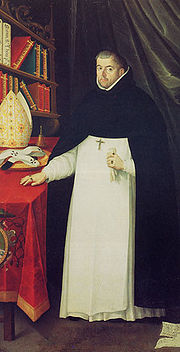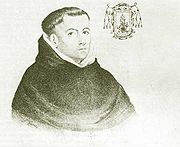
García Guerra
Encyclopedia

New Spain
New Spain, formally called the Viceroyalty of New Spain , was a viceroyalty of the Spanish colonial empire, comprising primarily territories in what was known then as 'América Septentrional' or North America. Its capital was Mexico City, formerly Tenochtitlan, capital of the Aztec Empire...
. He held the former office from December 3, 1607 and the latter from June 19, 1611. He still occupied both offices at the time of his death in 1612.
He took up the habit of the Dominicans in the Spanish monastery of San Pablo de Valladolid, where he was prior and principal of the province. In 1607 Philip III
Philip III of Spain
Philip III , also known as Philip the Pious, was the King of Spain and King of Portugal and the Algarves, where he ruled as Philip II , from 1598 until his death...
named him archbishop of Mexico.
In 1611 a letter was received in Mexico City from Spain ordering the sitting viceroy, Luis de Velasco, marqués de Salinas
Luis de Velasco, marqués de Salinas
Luis de Velasco, marqués de Salinas , Spanish nobleman, son of the second viceroy of New Spain, and himself the eighth viceroy. He governed from January 27, 1590 to November 4, 1595, and again from July 2, 1607 to June 10, 1611...
to return to the mother country to take charge of the Council of the Indies, and directing García Guerra to fill the position of viceroy. The letter stipulated that Velasco was to remain in charge of the viceregal government until his actual departure from the colony. Velasco left the city on June 10, and Archbishop Guerra retired to Tacubaya
Tacubaya
Tacubaya is a section of Mexico City located in the west in the Miguel Hidalgo borough. The area has been inhabited since before the Christian era, with its name coming from Nahuatl meaning “where water is gathered.” From the colonial period to the beginning of the 20th century, Tacubaya was...
to await the news of his sailing from Veracruz
Veracruz
Veracruz, formally Veracruz de Ignacio de la Llave officially Estado Libre y Soberano de Veracruz de Ignacio de la Llave , is one of the 31 states that, along with the Federal District, comprise the 32 federative entities of Mexico. It is divided in 212 municipalities and its capital city is...
.

As viceroy, he worked to find funds to improve the drainage system of Mexico City, and to convince the native Spaniards to return land to the Indians. In the first objective he was not successful. He received a scientific report from the noted mathematician Ildefonso Arias that the project could not succeed because of the subterranean connection to the Río Acolhuacán. In the second objective he was not successful either, due to his short time in office and the strong opposition of the owners of the encomienda
Encomienda
The encomienda was a system that was employed mainly by the Spanish crown during the colonization of the Americas to regulate Native American labor....
s and latifundios.
On August 20, 1611 an earthquake caused much damage in the capital, and some damage in the provinces. Many buildings were destroyed.
Not long after becoming viceroy, Guerra suffered an injury in the descent from his coach. He was operated on without success, and he died in 1612. He was interred with much ceremony in the cathedral of Mexico City. After his death, the Audiencia assumed the government, pending the arrival of his replacement. A few days later the Audiencia suppressed a conspiracy of Negroes, hanging 29 men and four women.
External links
- Catholic Hierarchy List of Archbishops of Mexico

